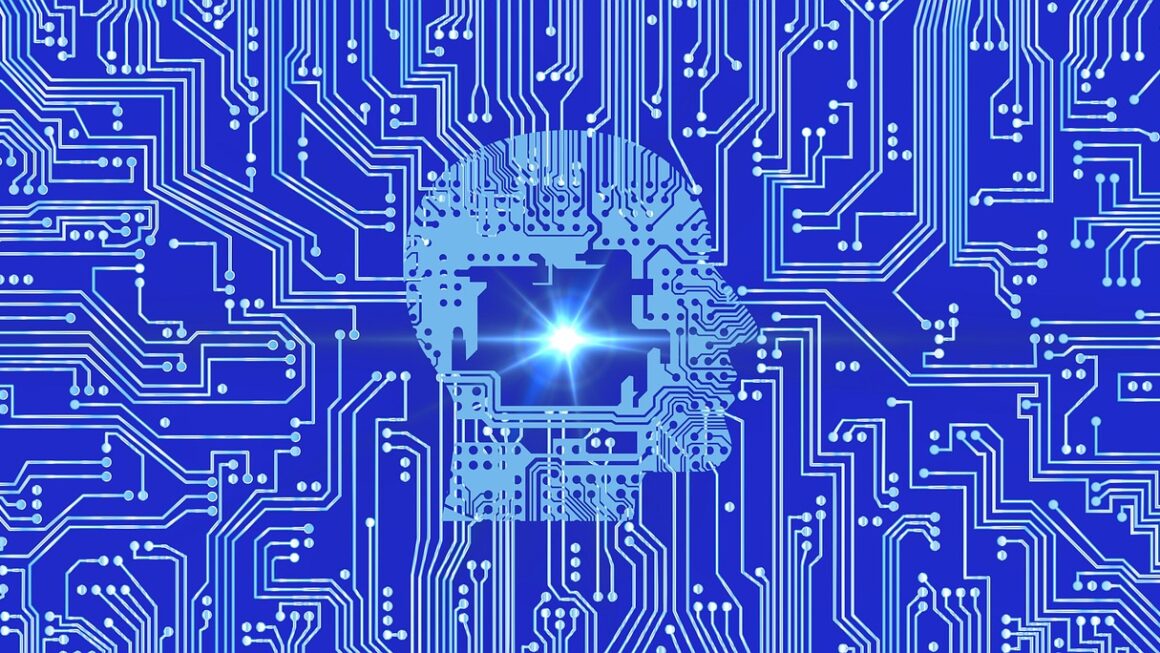Artificial intelligence (AI) is rapidly transforming our world, impacting everything from how we work and communicate to how we diagnose diseases and explore the universe. But what exactly is AI, and how is it being used in practical applications today? This comprehensive guide will explore the fundamentals of AI, delve into its various branches, and examine real-world examples of its transformative power. Whether you’re an AI enthusiast or simply curious about this groundbreaking technology, this post will provide you with a solid understanding of artificial intelligence and its future potential.
What is Artificial Intelligence?
Defining AI: Mimicking Human Intelligence
At its core, artificial intelligence is the ability of a computer or a machine to mimic human cognitive functions such as learning, problem-solving, and decision-making. Unlike traditional programming, which requires explicit instructions for every task, AI systems learn from data, adapt to new situations, and improve their performance over time. This learning process often involves algorithms and statistical models that enable the system to identify patterns, make predictions, and automate tasks.
- Key Characteristics of AI:
Learning: Acquiring knowledge and skills from data.
Reasoning: Using learned knowledge to solve problems and make decisions.
Perception: Interpreting sensory inputs, such as images and speech.
Problem-Solving: Finding solutions to complex problems.
Types of AI: Narrow vs. General AI
AI can be broadly categorized into two types: Narrow AI (or Weak AI) and General AI (or Strong AI).
- Narrow AI (Weak AI): This type of AI is designed for a specific task and excels within its defined domain. Examples include:
Spam filters: Classifying emails as spam or not spam.
Recommendation systems: Suggesting products or content based on user preferences.
Virtual assistants (Siri, Alexa): Responding to voice commands and providing information.
Self-driving cars (Level 4 autonomy): Navigating roads under specific conditions.
- General AI (Strong AI): This is a more advanced form of AI that possesses human-level intelligence and can perform any intellectual task that a human being can. General AI does not currently exist, and its development remains a long-term goal.
Key Branches of Artificial Intelligence
Machine Learning (ML): Learning from Data
Machine learning is a subset of AI that focuses on enabling computers to learn from data without being explicitly programmed. ML algorithms identify patterns, make predictions, and improve their accuracy over time.
- Types of Machine Learning:
Supervised Learning: Training a model on labeled data to predict outcomes. Example: predicting customer churn based on historical data.
Unsupervised Learning: Discovering patterns and structures in unlabeled data. Example: clustering customers into different segments based on their purchasing behavior.
Reinforcement Learning: Training an agent to make decisions in an environment to maximize a reward. Example: training a robot to navigate a maze.
- Practical Example: Imagine a company wants to predict which customers are likely to default on their loans. Using supervised machine learning, they can train a model on historical loan data, including factors like credit score, income, and debt-to-income ratio. The model can then predict the likelihood of default for new loan applicants.
Natural Language Processing (NLP): Understanding and Generating Human Language
Natural language processing focuses on enabling computers to understand, interpret, and generate human language. NLP is used in a wide range of applications, including chatbots, machine translation, and sentiment analysis.
- Applications of NLP:
Chatbots: Providing customer support and answering questions.
Machine Translation: Translating text from one language to another.
Sentiment Analysis: Determining the emotional tone of text, such as customer reviews.
Voice assistants: Understanding and responding to voice commands.
- Practical Example: A company can use sentiment analysis to monitor social media mentions of their brand and identify potential issues or negative feedback. By analyzing the sentiment expressed in the comments, they can quickly respond to customer concerns and improve their brand image.
Computer Vision: Seeing and Interpreting Images
Computer vision allows computers to “see” and interpret images and videos. It involves tasks such as object recognition, image classification, and image segmentation.
- Applications of Computer Vision:
Facial Recognition: Identifying individuals in images or videos.
Object Detection: Detecting and locating objects in images or videos.
Medical Imaging: Analyzing medical images to detect diseases.
Autonomous Vehicles: Enabling cars to “see” and navigate their surroundings.
- Practical Example: In the healthcare industry, computer vision is used to analyze medical images, such as X-rays and MRIs, to detect anomalies and assist doctors in making more accurate diagnoses. This can lead to earlier detection of diseases and improved patient outcomes.
Robotics: Combining AI with Physical Machines
Robotics combines artificial intelligence with physical machines to create robots that can perform a variety of tasks. Robots can be used in manufacturing, healthcare, and exploration.
- Applications of Robotics:
Manufacturing: Automating tasks on assembly lines.
Healthcare: Assisting with surgeries and providing patient care.
Exploration: Exploring hazardous environments, such as underwater or in space.
Logistics: Automating warehouse operations and delivery services.
- Practical Example: In manufacturing, robots are used to automate repetitive tasks, such as welding and painting, which increases efficiency, reduces costs, and improves the quality of products. Collaborative robots (cobots) work alongside human workers, assisting them with physically demanding or dangerous tasks.
Real-World Applications of AI
AI in Healthcare: Improving Patient Outcomes
AI is revolutionizing healthcare by improving diagnosis, treatment, and patient care.
- AI Applications in Healthcare:
Disease Diagnosis: Analyzing medical images and patient data to detect diseases earlier and more accurately.
Personalized Medicine: Tailoring treatment plans to individual patients based on their genetic makeup and medical history.
Drug Discovery: Accelerating the process of identifying and developing new drugs.
Robotic Surgery: Assisting surgeons with complex procedures, increasing precision and reducing recovery times.
AI in Finance: Automating and Optimizing Financial Processes
AI is transforming the financial industry by automating tasks, improving risk management, and enhancing customer service.
- AI Applications in Finance:
Fraud Detection: Identifying and preventing fraudulent transactions.
Algorithmic Trading: Automating trading strategies based on market data and algorithms.
Credit Scoring: Assessing the creditworthiness of loan applicants.
Chatbots: Providing customer support and answering financial questions.
AI in Retail: Enhancing Customer Experience
AI is helping retailers improve the customer experience by personalizing recommendations, optimizing inventory management, and automating customer service.
- AI Applications in Retail:
Personalized Recommendations: Suggesting products or content based on customer preferences.
Inventory Management: Optimizing inventory levels to meet demand and reduce costs.
Chatbots: Providing customer support and answering questions about products and services.
Predictive Analytics: Forecasting future demand and optimizing pricing strategies.
The Future of Artificial Intelligence
Ethical Considerations: Addressing Bias and Ensuring Fairness
As AI becomes more prevalent, it’s crucial to address ethical considerations such as bias, fairness, and transparency. AI systems can perpetuate biases present in the data they are trained on, leading to unfair or discriminatory outcomes.
- Addressing Ethical Concerns:
Data Bias Mitigation: Ensuring that training data is representative of the population and mitigating biases.
Transparency and Explainability: Developing AI systems that are transparent and explainable, allowing users to understand how decisions are made.
Accountability and Responsibility: Establishing clear lines of accountability and responsibility for the actions of AI systems.
The Singularity: A Hypothetical Future
The singularity is a hypothetical point in time when technological growth becomes uncontrollable and irreversible, resulting in unforeseeable changes to human civilization. Some futurists believe that the development of general AI could lead to the singularity. While the singularity remains a speculative concept, it highlights the potential for AI to have profound and transformative impacts on society.
The Ongoing Evolution of AI: Continuous Improvement
The field of artificial intelligence is constantly evolving, with new algorithms, techniques, and applications emerging all the time. As AI systems become more sophisticated, they will continue to transform our world in profound and unexpected ways. Continuous learning and adaptation will be key to navigating the ever-changing landscape of artificial intelligence.
Conclusion
Artificial intelligence is a powerful technology that is already transforming our world in numerous ways. From healthcare to finance to retail, AI is helping us solve complex problems, automate tasks, and improve efficiency. While ethical considerations and potential risks need to be addressed, the potential benefits of AI are immense. By understanding the fundamentals of AI and its various branches, we can harness its power to create a better future for all. Staying informed about the latest advancements and trends in AI will be essential for individuals and organizations alike to thrive in this rapidly evolving technological landscape.




